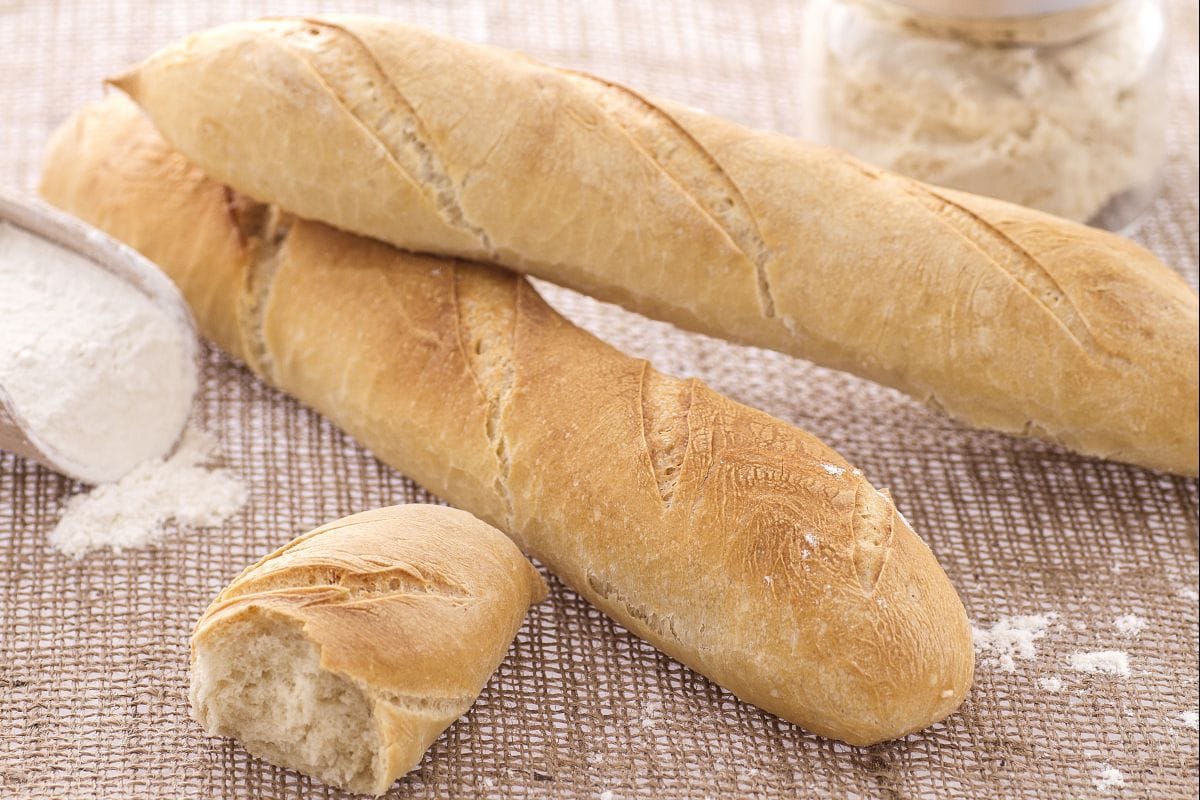Baked Caprese Crostini
- 30 min

If you're diving into the world of authentic French baking, this baguette con lievito madre is a must-try. The French—who really love their bread—capture that perfect blend of a crispy crust with a soft, slightly tangy inside. It's all about using a natural sourdough starter, known as lievito madre, and a touch of baker's yeast to get the rise just right.
Here's the thing: making a biga the night before, which is just flour, water, and yeast left to do its thing, is key. This process gives the bread that special tender feel and depth of flavor unique to pane francese con lievito madre. For those who appreciate good bread, these steps, combined with multiple proofing stages, are essential. Seriously good texture.
The classic shape and appearance of a baguette come from careful shaping and those distinctive slashes on top—made with a razor right before baking. Pretty simple but important. This technique ensures that when it's baked in a super-hot, steamy oven—often with a tray of water for added humidity—it achieves that golden, shatteringly crispy crust while keeping the inside moist. In France, you'll often see a fresh baguette under someone's arm or peeking out of a tote bag. And look, it's ready to be enjoyed with anything.
It's especially fantastic with dishes like soupe à l’oignon. Patience is key here, from the slow rising times to achieving the perfect finish. Balancing the natural starter with a touch of commercial yeast is a traditional move in ricetta baguette lievito madre, controlling the rise and enhancing flavor. Whether you're into panificazione casalinga or eager to make your own baguette fatta in casa, this bread is a rite of passage.
Once you smell that fresh, crispy loaf coming out of your oven, you'll really understand why it's such a beloved staple in French culture. It's not just about baking bread; it's about embracing a bit of French daily life and savoring the simple, yet profound pleasure of a well-made baguette. Truly amazing stuff.
You might also like:

To prepare the baguette with sourdough, start the day before by kneading the biga: dissolve 5 g of yeast in the water 1 and arrange the flour in a mound, then gradually pour the water with the yeast into the center 2 and knead with your hands to obtain a smooth dough 3.

Store the biga in a tall, slightly oiled container 4 covered with plastic wrap 5. Let the biga rise for about 12 hours, after which it will have doubled in volume and will appear with large bubbles 6.

The next day you can proceed to prepare the actual baguette: dissolve the salt in 200 ml (about 7/8 cup) of warm water and the two grams of yeast in the remaining 200 ml (about 7/8 cup) of water (7-8). Mix the all-purpose and bread flours together in a bowl 9 (you can use a stand mixer with a hook attachment or your hands to knead).

Add the biga 10, the sourdough 11, and gradually add the water and yeast mixture 12, kneading well.

Continue kneading, also adding the water with the salt: the result should be a smooth, soft, and homogeneous dough 13. Cover the dough with plastic wrap 14 and let it rise for a couple of hours in the oven with the light on until it doubles in volume 15.

Divide the dough into 6 pieces of 200 g (about 7 oz) each 16, then roll each piece out with a rolling pin 17 and roll them from the shorter side, pressing gently towards the center 18.

Let the obtained cylinders rest on a floured tray for 45 minutes to 1 hour, keeping the seam line facing down 19. After this time, roll the cylinders out again with the rolling pin 20 and roll them this time from the long side 21.

Press with both hands 22 and stretch the baguette to about 35 cm (approximately 14 inches), tapering the ends 23. Place the baguettes on a floured cloth, spaced apart by the folds of the towel, and let them rise for another hour 34. After half an hour, start preheating the oven to 250°C (about 482°F) and place a tray with boiling water at the bottom to create steam and make the oven humid; also heat the baking tray on which you will bake the baguettes.

Before baking, make decisive cuts along the surface of the baguettes with a razor blade 25 and spray them with water using a nebulizer 26. Take out the hot baking tray and slide the baguettes onto it directly from the towel (be careful not to handle them too much to avoid deflating the rise). Lower the oven to 340°C (about 464°F) and bake the baguettes at this temperature for 30 minutes. When the baguette begins to brown, open the oven door a couple of times to let the steam dissipate and the bread surface dry to create the crust. Turn off the oven and leave the baguettes for another ten minutes; then take them out and let them cool on a rack 27: the baguette with sourdough is waiting for you!